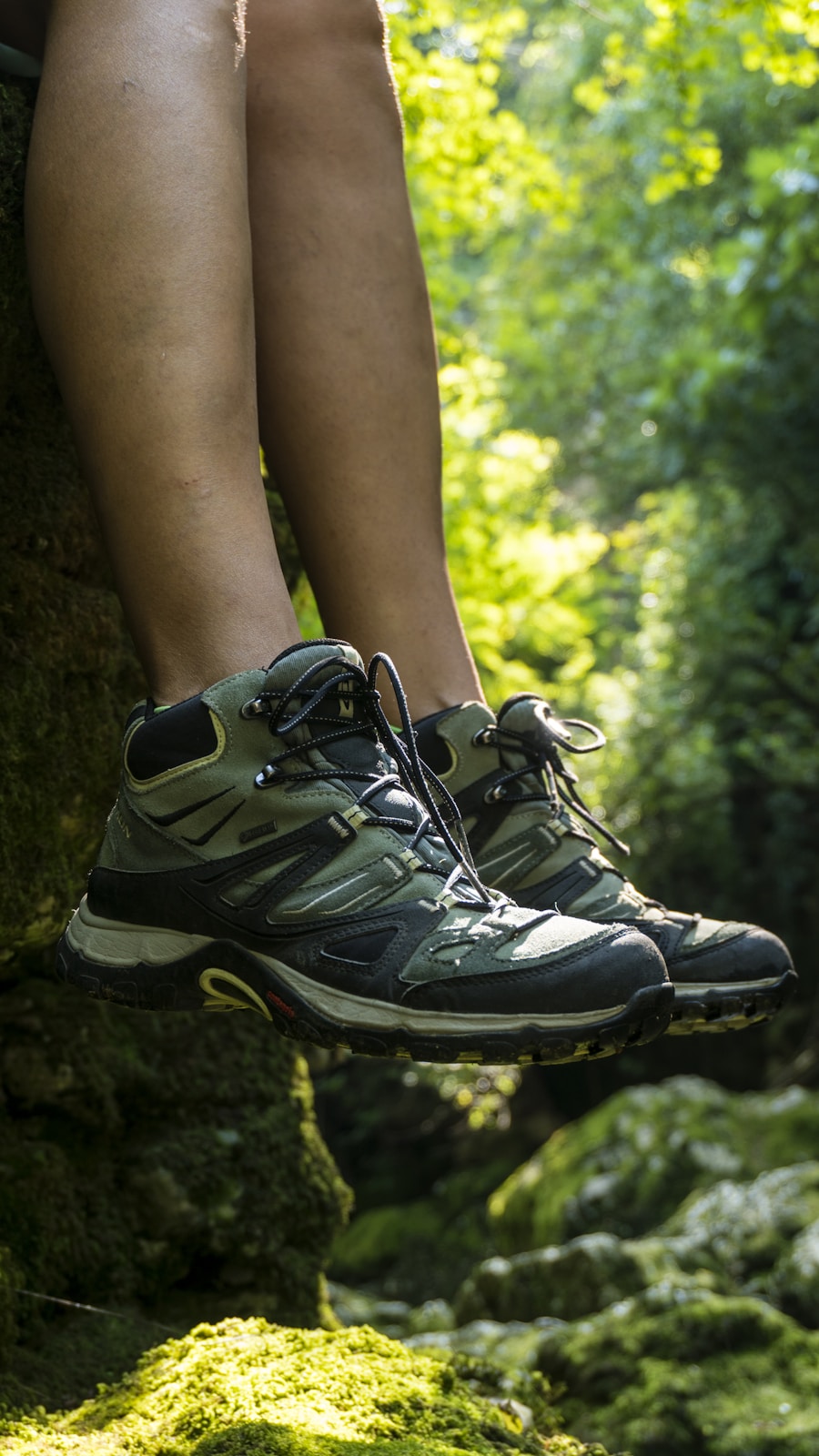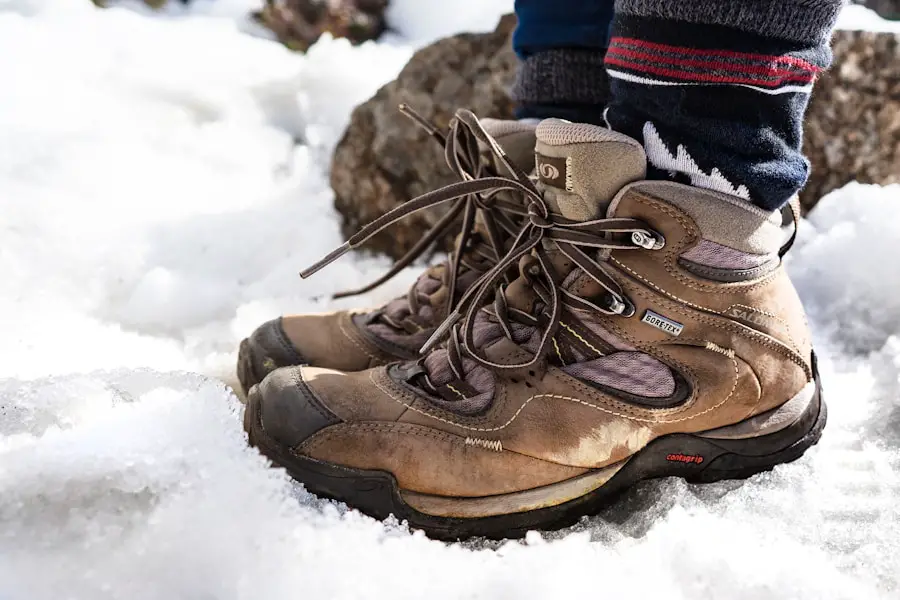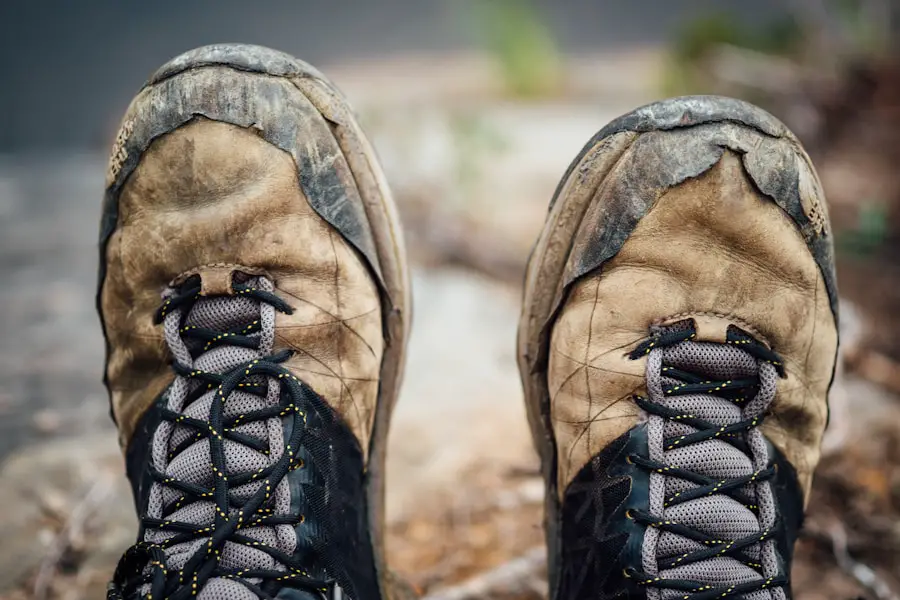Breaking in hiking boots is a crucial step that can significantly enhance the overall hiking experience. New boots, while often visually appealing and equipped with the latest technology, can be stiff and unforgiving. This rigidity can lead to blisters, discomfort, and even injuries during long hikes.
The process of breaking in allows the materials to soften and conform to the unique shape of your feet, creating a personalized fit that enhances comfort and support. When boots are properly broken in, they can provide the necessary stability and protection against the rugged terrain that hikers often encounter. Moreover, breaking in hiking boots is not just about comfort; it also plays a vital role in performance.
Well-broken-in boots can improve traction and responsiveness, allowing hikers to navigate challenging trails with greater ease. The right fit can also enhance balance, reducing the risk of slips and falls on uneven surfaces. As hikers prepare for longer treks, such as a 50-mile milestone, the importance of having boots that feel like an extension of their feet cannot be overstated.
A well-fitted boot can make the difference between an enjoyable adventure and a painful ordeal.
Key Takeaways
- Breaking in hiking boots is important to prevent blisters and discomfort on the trail
- Choosing the right hiking boots that fit well and provide proper support is crucial for a successful hike
- Preparing for a 50-mile hike requires physical conditioning and mental preparation
- Tips for breaking in hiking boots include wearing them around the house and gradually increasing wear time
- Dealing with discomfort while breaking in hiking boots may require adjusting lacing or using moleskin for hot spots
- Taking care of your feet with proper hygiene and foot care can prevent issues while breaking in hiking boots
- Knowing when your boots are ready for the trail involves feeling comfortable and confident in them during shorter hikes
- Enjoying the benefits of well-broken-in boots includes improved comfort, support, and performance on the trail
Choosing the Right Hiking Boots
Selecting the appropriate hiking boots is foundational to a successful hiking experience. The market offers a plethora of options, ranging from lightweight trail runners to heavy-duty mountaineering boots, each designed for specific conditions and types of terrain. When choosing hiking boots, it is essential to consider factors such as the type of hiking you plan to do, the climate, and your personal foot shape.
For instance, if you are planning to hike on well-maintained trails during warmer months, a lightweight boot or trail runner may suffice. Conversely, if your adventures lead you into rugged backcountry or snowy conditions, a more robust boot with insulation and waterproofing features will be necessary. Fit is another critical aspect when selecting hiking boots.
It is advisable to try on several pairs at the end of the day when your feet are slightly swollen, as this will give you a more accurate representation of how they will feel during extended wear. Pay attention to the width and arch support; some brands cater to wider feet or offer different arch profiles. Additionally, consider the boot’s weight; while lighter boots can reduce fatigue over long distances, heavier boots often provide better ankle support and durability.
Ultimately, the right pair of hiking boots should feel snug but not constricting, allowing for some movement without excessive slippage.
Preparing for the 50-Mile Milestone

Preparing for a 50-mile hike is no small feat; it requires careful planning and training. One of the first steps in this preparation is to ensure that your gear, particularly your hiking boots, is up to the challenge. This preparation involves not only selecting the right boots but also ensuring they are adequately broken in before embarking on such a demanding journey.
A 50-mile trek can take several days, depending on your pace and the terrain, making it essential to have footwear that supports your feet over long distances without causing pain or discomfort. In addition to breaking in your boots, physical conditioning is vital for tackling a 50-mile hike. Gradually increasing your mileage through training hikes will help build endurance and strength in your legs and feet.
Incorporating varied terrain into your training will also prepare you for the challenges you may face on the actual hike. Alongside physical training, mental preparation is equally important; developing a positive mindset and strategies for dealing with fatigue can make a significant difference during long hikes. By combining proper gear preparation with physical and mental training, you set yourself up for success on your 50-mile adventure.
Tips for Breaking in Hiking Boots
| Tip | Description |
|---|---|
| Choose the right size | Ensure your hiking boots fit properly to prevent blisters and discomfort. |
| Break them in gradually | Wear your boots for short walks before going on long hikes to allow them to mold to your feet. |
| Use thick socks | Wearing thick, moisture-wicking socks can help prevent friction and blisters. |
| Apply waterproofing treatment | Protect your boots from water and moisture by applying a waterproofing treatment. |
| Keep them clean | Regularly clean your boots to prevent dirt and debris from damaging the material. |
Breaking in hiking boots effectively requires a strategic approach to ensure comfort and prevent injury during hikes. One of the most effective methods is to wear your new boots around the house or during short walks before hitting the trails. This initial phase allows you to assess any pressure points or areas of discomfort without committing to a long hike.
Gradually increasing the duration and intensity of wear will help the materials soften and mold to your feet over time. Another useful technique is to wear thick socks while breaking in your boots. This added layer can help stretch the material slightly and provide additional cushioning against friction.
It’s also beneficial to walk on various surfaces—hardwood floors, carpets, and even uneven ground—to simulate different hiking conditions. If possible, incorporate some light hiking into your break-in routine; this will not only help with fitting but also allow you to test the boot’s performance on actual trails. Remember that patience is key; breaking in boots is not an overnight process but rather a gradual journey toward achieving optimal comfort.
Dealing with Discomfort
Experiencing discomfort while breaking in hiking boots is not uncommon, but knowing how to address it can make all the difference in your hiking experience. Blisters are one of the most frequent issues hikers face when wearing new boots. To mitigate this risk, it’s essential to keep an eye on areas where friction occurs most often—typically around the heels and toes.
Applying blister prevention products such as moleskin or specialized blister pads can provide an extra layer of protection during the break-in period. If discomfort persists despite preventive measures, it may be necessary to reassess the fit of your boots. Sometimes, minor adjustments can be made by loosening or tightening laces or using different insoles for better arch support.
In some cases, visiting a professional boot fitter can provide insights into whether your boots are suitable for your foot shape or if modifications are needed. Understanding that discomfort is part of the process can help maintain motivation; however, it’s crucial to listen to your body and take breaks as needed to avoid more severe injuries.
Taking Care of Your Feet

Proper foot care is essential for any hiker, especially when preparing for long-distance treks like a 50-mile hike. Maintaining foot health begins with hygiene; keeping feet clean and dry helps prevent blisters and fungal infections. After each hike or training session, it’s advisable to wash your feet thoroughly and dry them completely before putting on socks or shoes again.
Additionally, using moisture-wicking socks can help keep feet dry by drawing sweat away from the skin. Regular foot inspections are also vital; checking for any signs of redness, swelling, or blisters can help catch potential issues early on. If you notice any abnormalities, addressing them promptly can prevent more significant problems down the line.
Stretching exercises for your feet and calves can improve flexibility and reduce tension during long hikes. Incorporating foot massages or using a foam roller on your calves can also aid recovery after strenuous activities. By prioritizing foot care throughout your training and hiking experiences, you set yourself up for greater comfort and success on the trails.
Knowing When Your Boots are Ready
Determining when your hiking boots are ready for serious use involves paying attention to both physical cues from the boots themselves and how they feel on your feet during wear. A well-broken-in boot should feel comfortable without any pinching or excessive movement within the shoe. The materials should have softened enough to allow for natural foot movement while still providing adequate support and protection against external elements.
Another indicator that your boots are ready is their performance during test hikes. If you’ve completed several shorter hikes without experiencing significant discomfort or blisters, it’s likely that your boots have reached an acceptable level of break-in. Additionally, consider how well they handle various terrains; if they provide good traction and stability on different surfaces without feeling cumbersome or restrictive, they are likely prepared for longer adventures.
Trusting your instincts about comfort and fit is essential; if something feels off during testing, it may be worth continuing the break-in process before committing to longer hikes.
Enjoying the Benefits of Well-Broken-In Boots
Once you’ve successfully broken in your hiking boots, you’ll likely experience a range of benefits that enhance your overall hiking experience. The most immediate advantage is comfort; well-broken-in boots should feel like a natural extension of your feet rather than an encumbrance. This comfort allows you to focus on enjoying the scenery and engaging with nature rather than being preoccupied with foot pain or discomfort.
Additionally, properly broken-in boots contribute significantly to performance on challenging trails. With improved flexibility and responsiveness, hikers can navigate rocky paths or steep inclines with greater ease and confidence. The enhanced fit reduces the likelihood of blisters and other foot-related issues, allowing for longer hikes without interruption.
Ultimately, investing time in breaking in your hiking boots pays off by transforming them into reliable companions that support you through every step of your outdoor adventures.
If you’re planning a hiking trip, it’s important to break in your hiking boots properly to avoid discomfort and blisters. According to TakeTravelInfo, it typically takes around 30-50 miles of hiking to fully break in a new pair of boots. This article provides helpful tips on how to break in your hiking boots effectively to ensure a comfortable and enjoyable hiking experience.
FAQs
What is the purpose of breaking in hiking boots?
Breaking in hiking boots helps to soften the materials, mold them to the shape of your feet, and reduce the risk of blisters and discomfort during long hikes.
How many miles does it take to break in hiking boots?
The number of miles it takes to break in hiking boots can vary depending on the individual and the type of boots. Generally, it can take anywhere from 30 to 50 miles of hiking to fully break in a new pair of boots.
What are some tips for breaking in hiking boots?
Some tips for breaking in hiking boots include wearing them around the house before hitting the trails, gradually increasing the distance of your hikes, and using thick hiking socks to help cushion your feet.
What are the signs that hiking boots are fully broken in?
Signs that hiking boots are fully broken in include a comfortable fit with no pressure points or hot spots, the materials feeling more flexible, and the boots providing good support and traction on the trails.
Can I speed up the process of breaking in hiking boots?
While it’s important to allow time for the boots to naturally mold to your feet, you can speed up the process by wearing them on shorter hikes, using a boot stretcher, or applying leather conditioner to soften the materials.
